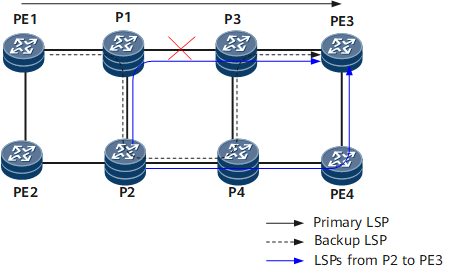Assigning Labels to Both Upstream and Downstream LSRs
This sub-feature solves the possible problem of slow convergence if a link becomes faulty.
When labels only are distributed for upstream LSRs, an LSR checks the upstream/downstream relationship with peers in LDP sessions according to routing information before sending Label Mapping messages. An upstream LSR will not send a Label Mapping message associated with a route specified to its downstream LSR. If the route changes and the upstream/downstream relationship is switched, the new downstream LSR resends the Label Mapping message, which slows convergence.
With this feature, each LSR can send Label Mapping messages to all peers irrespective of upstream or downstream relationships.
In Figure 1, P2 and PE3 are connected along the paths P2 -> P1 -> P3 -> PE3 and P2 -> P4 -> PE4 -> PE3. According to the routes on the loopback interface of PE3, P1 is the next hop of P2. When labels can only be assigned to upstream nodes and P2 receives a Label Mapping message from P1, it does not send the Label Mapping message associated with the route to P1. If the link between P1 and P3 is faulty, the route from PE1 to PE3 is switched from PE1 -> P1 -> P3 -> PE3 to PE1 -> P1 -> P2 -> P4 -> P3 -> PE3 and P2 becomes the downstream node of P1. The LSP can only be set up after P2 resends a Label Mapping message. However, P2 does not send the Label Mapping message to P1, which slows LSP re-convergence.
When LDP is enabled to distribute labels to all peers, P2 sends a Label Mapping message associated with the route to P1 after receiving the Label Mapping message from P1, which allows LDP to generate a liberal LSP on P1. If the link between P1 and P3 becomes faulty, the route from PE1 to PE3 is switched from PE1 -> P1 -> P3 -> PE3 to PE1 -> P1 -> P2 -> P4 -> P3 -> PE3, P2 becomes the downstream of P1, and the liberal LSP changes to a normal LSP, which accelerates LSP convergence.
In addition, split horizon can be configured to have Label Mapping messages only sent to specified upstream LSRs.
